The Stories Behind Classic Christmas Carols
by Howard Fosdick © FolkFluteWorld.com.
Ever wonder about the origins of Christmas songs? I did... hence this article.
How old is The Coventry Carol? Is Silent Night a German song? Which Christmas songs are based on old church hymns or traditional folk songs, and which were composed in modern times?
This article shares the stories behind several classic songs we identify with Christmas. Most are "Christmas Carols," that is, melodies for carollers or church. Others have more recent origins.
Before we start, here's free access to the sheet music for hundreds of Christmas songs. All are scored in keys that you can play on nearly any folk flute.
- Download 100 classics including all the tunes in this article in a single "zip" file here
- Download Paul Hardy's free Christmas Tunebook
- For something different, download this song book of Catalonian Christmas tunes
- Link to a page with 60 different Christmas songs in various keys at Mountain Ocarina
- Links to a twenty Christmas songs at Ocarina Tabs and twenty more at Capotato Music
Now let's take a look at some of the stories behind the songs. Click the highlighted song titles to view the sheet music.
Silent Night
Silent Night was first performed in a small town in Austria in 1818. Its original lyrics were written in German.
Like many of the best carols, Silent Night is actually a poem set to music. Young assistant priest Joseph Mohr wrote the poem; schoolmaster Franz Gruber composed the melody. The way the story goes is that the church's organ had broken down. So Mohr asked Gruber to write a tune to fit his lyrics and that would work well with guitar accompaniment. The song was first publically performed at midnight mass in the little Obernborf church in 1818.
Some say that Mohr became determined to set his poem to music when he walked home over a hill one winter night, and witnessed the town sleeping in the snow below him. The silence of the winter's night touched him.

The story of who wrote the song eventually became lost to history. Some believed that only someone famous could have written such a classic, for example, Haydn, Mozart, Beethoven or Schubert. But in 1995 an original manuscript was found with Mohr's handwriting that refutes all such claims and proves the song's true provenance.
There have been many fictionalized accounts of how such a classic song could have been created. One of the best is the film Silent Night from 2012. This movie posits that a young Joseph Mohr was at odds in his new parish duties with the priest in charge. Mohr brings in new church members from among those he meets at a tavern. And he insists on services the people can understand -- in German -- instead of the traditional Latin. Church membership spikes, but the head priest wants to banish Mohr.
The dramatic conclusion before Mohr's departure is a triumphant singing of his poem, Silent Night. The film is highly rated over at the IMDB Movie Database and is well worth your time.
Who knows how much of it is true? Whatever the case, it's a fine, sensitive film that truly brings to life the spirit of the famous song.
Have Yourself A Merry Little Christmas
Back in 1944, songwriter Hugh Martin was trying to compose a Christmas song for what turned out to be the classic film Meet Me in St. Louis. It wasn't working. So he tossed it into the trash.
His song-writing partner Ralph Blane made him retrieve it. He felt the song was a bit too melancholy but had potential. The partners rewrote it to make it a bit more upbeat. The rest is history, both for the film and the song -- which went on to be successfully recorded by everyone from Frank Sinatra to Twisted Sister to Tori Amos, Christina Aguilera, Judy Garland, and NewSong's Michael O'Brien.
Years later, there was a bit of controversy over who wrote the song. While Martin and Blane typically collaborated on all their songs, Martin claimed exclusive credit for this one. Who knows?
In 2007, ASCAP ranked Have Yourself a Merry Little Christmas the third most performed Christmas song ever written by its members.
Rudolph the Red Nosed Reindeer
Everybody's favorite jingle started off as... an advertising slogan?
Yikes! That requires some explanation.
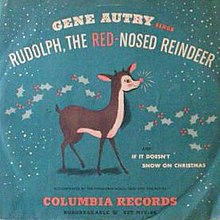
Reindeer Record Cover
(Courtesy Wikipedia)
Johnny Marks was an accomplished songwriter back in the mid-twentieth century. Among others classics, he penned Rockin' Around the Christmas Tree (Brenda Lee), A Holly Jolly Christmas (Burl Ives), and I Heard the Bells on Christmas Day (Bing Crosby). That's quite a list!
Johnny Mark's brother-in-law, Robert May, created the character Rudolph for an advertising campaign by Montgomery Ward. According to History.com, “As he peered out at the thick fog that had drifted off Lake Michigan, May came up with the idea of a misfit reindeer ostracized because of his luminescent nose, who used his physical abnormality to guide Santa’s sleigh and save Christmas.”
May loved alliteration and banded about names until he came up with "Rudolph, the Red Nosed Reindeer." May's booklet on Rudolph became a huge hit for Wards. Then Johnny Marks took the concept and put it to song a couple years later.
They offered their creation to the man who was "Mr. Christmas" at that time, Bing Crosby. But Bing turned it down. Bad move. America's singing cowboy, Gene Autry, recorded the song instead. His version sold a couple million copies and the tune continues as one of the nation's most-beloved Christmas tunes ever. How many other songs do you know the words to by heart?
Johnny Marks was abducted into the Songwriters Hall of Fame in 1961. He passed away at the age of 75 in 1985.
It's the Most Wonderful Time of the Year
Andy Williams was a popular personality who hosted his own television variety show in the 1960s until 1971. All the while -- well into the 1990s -- he also hosted his yearly Christmas Specials. These became family favorites and still air even today every Christmas season.
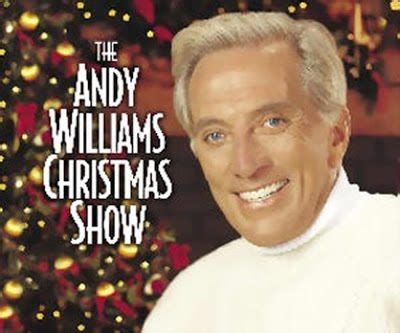
Born in 1927, Williams initially joined his three older brothers -- Bob, Don, and Dick -- in forming a brothers quartet when they were teens. Their early claim to fame was as backup singers for Bing Crosby on his 1944 hit record, Swinging on a Star.
By the 1950s, Andy had gone solo. He became a household name. He frequently appeared on the Tonight Show with host Steve Allen and in various MGM films and musicals.
Williams became best-known for his own variety show, The Andy Williams Show, which ran from 1962 to 1971. It was during this time that he recorded the Andy Williams Christmas Album. It's the Most Wonderful Time of the Year first appeared on this album.
Ironically, the record company promoted Andy's version of White Christmas as the album's centerpiece. This relegated It's the Most Wonderful Time to secondary status.
It's one of life's ironies that Most Wonderful Time became the much bigger hit, but only after decades had proved its popularity. Only in the early 2000s did the song consistently break into the Billboard Hot 100 singles chart. It peaked at number 5 in 2020. Today it always pops up in any list of the most popular Christmas songs.
After his TV show ended, Andy Williams built his own venue, The Moon River Theatre. He performed there from the early 1990s to 2012. (Here's the sheet music for Moon River, Andy's theme song).
Williams was married to Claudine Longet from 1961 until their divorce in 1975. Williams met the French singer when her car broke down in Las Vegas and he offered to help. The couple had three children, and the entire family always appeared together on Andy's Christmas Specials.
A year after they were divorced, Longet shot and killed her boyfriend, skier Spider Sabich, at their home in Aspen. Longet claimed it was an accident and served only 30 days in jail. Many believe the sexism predominant 55 years ago saved her from a much longer sentence. As one of the jurors said, "I wouldn’t want her to go to prison, heavens no... By no means is she the type of person who should be in jail."
In any case, the cause célèbre ended Longet's career as an actress and singer. She's lived in relative obscurity ever since.
The much beloved Andy Williams passed away in 2012 at the age of 84.
Jingle Bells
Jingle Bells started its life a little bit differently than you might expect. It was composed by James Lord Pierpont in Medford, Massachusetts, about 1850. He called it The One Horse Open Sleigh. It didn't become identified as a Christmas song until decades after it was written. So, how did that happen?

Pierpont was a nephew of the famously wealthy John Pierpont Morgan. He didn't intend his melody as a Christmas tune. In fact, he wrote it at Thanksgiving. Some believe he might have meant it as a drinking song!
Pierpont was a Confederate sympathizer during the Civil War. He dedicated the song to John P. Ordway, manager of a blackface minstrel troupe. That's a sad and dispiriting footnote to one of the all-time great Christmas songs.
"Jingle Bells" was added to the song's title in 1859. It was at that time that the sheet music first appeared with sleigh bells on the horses pulling the sleigh. This image lead to the song gradually becoming identified with the holiday season.
Jingle Bells became ever more popular as the years marched on. Bing Crosby and the Andrews Sisters, Benny Goodman, and Glenn Miller all recorded the tune to great success in the 1940s. By that time, Jingle Bells was assured of its unique status as an iconic Christmas classic.
I don't know how many Christmas songs you've memorized the words to, but surely Jingle Bells makes the list. It's a true holiday classic.
Grandma Got Run Over by a Reindeer
Ugh. Not my favorite song. Not really very Christmassy, either. But it's popular, that's for certain. You can't avoid this novelty song if you listen to popular radio. So, what's the story?
This is what they often refer to as a "one-hit wonder." Elmo and Patsy first recorded it in 1979.
Composer Randy Brooks wrote the song when he had car trouble near Lake Tahoe and became stranded. He says it was inspired by a tipsy uncle, the comedian Foster Brooks. Apparently Brooks often performed his act while under the influence.
The lyrics describe how Grandma got drunk on eggnog one Christmas Eve, wandered out into the snow, and got trampled to death by Santa Claus and his reindeer. Certainly puts you in the mood for holiday cheer, doesn't it?
Ugh. It's interesting to hear the background of this strange song, but let's move on.
We Wish You a Merry Christmas
We Wish You a Merry Christmas is a traditional English carol whose origins are lost in history. Many believe it was once a popular drinking song, or wassail. Whatever its origins, we know that its modern popularity is due to English composer and musician Arthur Warrell (1883-1939). Warrell arranged the tune in 1935, and it was published by Oxford University Press. Thus it was formalized and spread around the world.
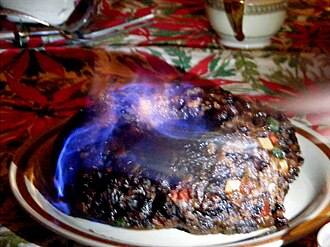
(Courtesy Wikipedia)
Now on the question everyone always asks. What is figgy pudding? Is it a real thing? And how does it taste?
Figgy pudding dates back to medieval times. It's one of several dishes made with fruits, nuts, honey, and sometimes rum or other liquor. I tried a modern recipe for it and can tell you: all you really need to know is that it tastes terrible!
Perhaps tastes were different hundreds of years ago, when modern cakes and sweets were not available. Still, it's difficult to imagine anyone getting excited over figgy pudding. Fortunately, even if the dessert falls short, the song is worthy of your enthusiasm.
The Christmas Song
Have you ever heard of The Christmas Song? Most people know it better under the moniker of its first line, Chestnuts Roasting on an Open Fire.
Singer/composer Mel Tormé wrote the song with Robert Wells, back when he was a young man in 1945.
As Wells tells the story, “It’s so damn hot today, I thought I’d writing something to cool myself off. All I could think of was Christmas and cold weather.”
Tormé penned the tune. In his autobiography he explained, “Improbable though it may sound, ‘The Christmas Song’ was completed about 45 minutes later.”
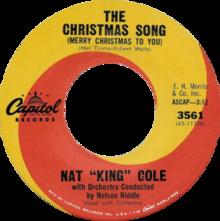
by Nat King Cole
(Courtesy Wikipedia)
That's not unusual. Many great songs are acts of spontaneous inspiration. It takes a few seconds to dream up the tune, then many hours of hard work to arrange and perfect it.
The Christmas Song has the distinction of being the first major Christmas classic popularized by a black American. Nat King Cole made a couple recordings of it in 1946. Both Mr Cole and the song went on to popular appreciation.
Cole's career consisted of a string of highlights. Certainly one of them was his Christmas album from the 1960s, ranked as one of the 40 best Christmas albums of all time by Rolling Stone magazine.
Unfortunately, Mr Cole passed away from cancer at the young age of 45 in 1965. It was the end of a career that never had a low point since he started playing Yes, We Have No Bananas on a church organ at age 4. For the subsequent four decades Nat spanned the gamut from jazz to gospel to popular tunes... and of course, his Christmas classics.
The Christmas Song (by Alvin, Simon, and Theodore)
You might think that Mel Tormé / Nat King Cole Christmas Song is the only seasonal song that goes by that simple title, but you'd be wrong. What many of us know as The Chipmunk's Christmas Song is also sometimes known by that same title. (Some even refer to it as Christmas Don't Be Late.)
You know the one I'm talking about, right? The strained voices of chipmunks Alvin, Simon, and Theodore belt out the famous lyrics:
Time for toys and time for cheer
We've been good but we can't last
Hurry Christmas, hurry fast
Want a plane that loops the loop
Me, I want a hula hoop
We can hardly stand the wait
Please Christmas, don't be late
Okay fellas get ready, that was very good Simon
Naturally, very good Theodore, ah
Ah Alvin, you were a little flat, watch it
Ah Alvin, Alvin, Alvin, okay
Want a plane that loops the loop
I still want a hula hoop
We can hardly stand the wait
Please Christmas, don't be late
We can hardly stand the wait
Please Christmas, don't be late
This classic was originally released in 1958. Composer Ross Bagdasarian sang all parts himself and varied the tape speeds to create the high-pitched chipmunk voices. He used his stage name of Davide Seville in the credits.
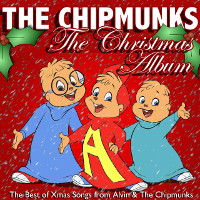
(Courtesy OpenSpotify.com)
The song won three grammies in 1958 and sold 4 million records in its first seven weeks after release. It reached #1 in the Billboard Hot 100 Pop Singles chart in the 1950s, then bopped back into high chart numbers for the next several years. Eventually it lofted into the stratosphere of Christmas classics with endless replays. The song continued its epic run by cracking the charts as late as the early 2000s. For example, in 2011, Nielsen SoundScan estimated the song sold some 867,000 downloads.
It's a natural that such a popular song would hit other media. It appeared, for example, in the 1983-1990 TV series, Alvin and the Chipmunks. It's popped up in any number of televised Christmas specials. And it's been used in films you would never guess, such as Rocky IV (1985), Look Who's Talking Now (1993), Donnie Brasco (1997), Almost Famous (2000), Whiskey Tango Foxtrot (2016) and The Fate of the Furious (2017).
Whew, that's quite a record (pun intended).
I Want a Hippopotamus for Christmas
While we're on novelty songs, here's another fun one. I just heard it at the mall, blaring over a loudspeaker, sung in jaunty style by a childrens' Christmas choir. (Does that get you in the mood to buy, or what?)
written by John Rox (1902–1957) in 1953 and sung by 10-year-old Gayla Peevey. The song cracked the charts but most probably remember it from when Ms Peevey performed it on the Ed Sullivan Show.
A fund was launched for donations to get the little girl her hippo. It succeeded, and as was always planned, she gave it to the Oklahoma City Zoo as their first hippo. He lived a long happy hippo life of over 50 years.
We Three Kings
We Three Kings is widely acknowledged as the first truly American Christmas carol. John Henry Hopkins, rector of an Episcopal in Williamsport, Pennsylvania, composed it in 1857.
The song alternates choruses of praise with descriptions of the gifts the three kings carry. These are the biblical magi, who visit baby Jesus in the famous manger scene depicted in every school play.
Hopkins initially had no intention of publishing this classic. It could have been lost to the ages. Fortunately, family and friends encouraged him, and he made it public in his 1863 book he entitled, Carols, Hymns, and Songs. And with that, a Christmas classic was born.
O Holy Night
O Holy Night consists of music written by Adolphe Adam to accompany the poem composed by Placide Cappeau. Cappeau wrote the lyrics in 1843 and Adam set it to music four years later.

(Courtesy Wikipedia)
John Sullivan Dwight adapted the French song to English a dozen years later. He was responsible for the subsequent popularity of the song in England and the United States.
Dwight was director of the Brook Farm commune, an 1840s intentional society. This commune was a utopian society based on the transcendentalist movement of the 1840s. All members -- including women -- shared equally in the work and the benefits of the communal farm.
Like many idealistic societies, Brook Farm disintegrated within six or seven years of its founding. It was later used as a Union Civil War camp, and today is on the National Register of Historic Places as a state-owned historic site.
Adolphe Adam, the French composer of the piece, went into music despite the admonitions of his father, a famous composer and pianist. For a while Adam went from strength to strength, experiencing solid success in the French theater.
Then in 1848, he lost all his money in a disastrous venture when he opened his own opera house in Paris. But the resourceful Adam bounced back based on his composing abilities. Ironically, nearly all his works are forgotten today. But he can proudly claim one huge exception: O Holy Night.
Coventry Carol
When did Christmas carols first become popular? One of the first ever referenced carols was The Angels' Hymn from 129 AD. As Christianity spread, hymns and carols like this one started replacing the pagan songs that celebrated the winter solstice. By the middle ages, this process was well along.
Perhaps the oldest printed carol is the Boar's Head Carol. It dates from 1521.

Another song from this period is The Coventry Carol. Most fans of this classic hymn don't realize that it was performed in England as part of a pageant that presents the "massacre of the innocents." This is the biblical event in which King Herod ordered all male infants to be murdered in Bethlehem. The carol is in fact a lament sung by the mothers of the doomed children.
Fortunately for the song's popularity, few modern listeners seem aware of its tragic nature. Many understand it merely as a medieval tune whose solemnity seems appropriate to represent the deeper meaning of Christmas.
Final Words
There are so many other great Christmas songs. But we have to stop somewhere, so that's it for now. Enjoy these classic melodies!
-------------------------------